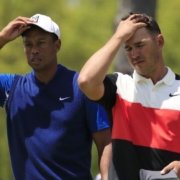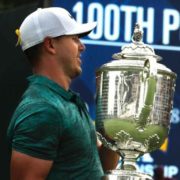Major questions about Tiger Woods, Brooks Koepka and more with Masters one month away
It’s hard to believe it has nearly been 365 days since Tiger Woods stunned the golf world by winning his fifth green jacket at the Masters.
The 84th edition of the Masters, the first major championship of the PGA Tour season, is only one month away.
There’s much uncertainty, starting with the defending champion. Woods’ aching back, which was a question mark a year ago, is once again a concern. So is Brooks Koepka’s game after knee surgery, and the uncertainty surrounding the coronavirus outbreak.
Here’s everything you need to know 30 days from the 2020 Masters:
Uncertainty and Tiger Woods
The Masters is only one month away, and defending champion Tiger Woodshasn’t played competitive golf in nearly as long.
Woods, 44, will skip the Players Championship this week after missing the WGC-Mexico Championship and Arnold Palmer Invitational, as well. He complained of back stiffness in mid-February at the Genesis Invitational in Los Angeles, where he finished last among players who made the cut.
His agent, Mark Steinberg, told ESPN in a text message on Friday that Woods’ back is “not concerning long term, just not ready.”
In a Twitter post on Friday, Woods wrote: “I have to listen to my body and properly rest when needed. My back is simply just not ready for play next week. I’m sad to miss one of the best events of the season, OUR championship.”
So what’s next for the 15-time majors champion? Even if his back is ready, will his game be ready if he can’t play in the upcoming Valspar Championship or WGC-Dell Technologies Match Play Championship?
It’s hard to imagine Woods not being back at Augusta National on April 9-12 to defend his Masters title. A year ago, he captivated the world when he came from behind to win there, after waiting 14 years to win his fifth green jacket. He became the second-oldest man to win the Masters, at 43 years, 3 months and 15 days old.
Another win at Augusta this year would tie him with Jack Nicklaus for the most Masters victories with six.
“It’s been incredible for myself and my family to be a part of this and for me to be the current Masters champion,” Woods told reporters in a teleconference last month. “It’s crazy that somehow it all came together for one week, one magical week.”
As magical as those 72 holes were a year ago, golf fans were also left wondering whether Sunday at Augusta in 2019 was a fitting end and the final crowning achievement to golf’s most legendary career.
After four back surgeries and another knee surgery in August, would Woods’ body allow him to continue contending at major championships? After winning the Masters, he missed cuts at the PGA Championship and Open Championship and withdrew from the Northern Trust.
After his fourth knee surgery, he unexpectedly won the Zozo Championship in Japan in October and went 3-0 at the Presidents Cup in December. He tied for ninth at the Farmers Insurance Open in his first event of 2020, and everything seemed fine until he suffered back stiffness at the Genesis.
While downplaying the injury at the Genesis, Woods said his plan was “to peak around Augusta time.”
Augusta time is almost here, and there are still plenty of questions when it comes to Woods.
Can Brooks Koepka find his game?
Woods isn’t the only golfer with big questions only a month from the Masters. Koepka, who only a year ago became the first player to hold back-to-back titles in two majors (PGA Championship and U.S. Open) simultaneously, all of the sudden can’t crack the top 40 at a tournament.
Koepka, who played with a painful knee injury for much of last season, hasn’t done much of anything since the end of the 2018-19 season. He missed the cut at the Shriners, withdrew from the CJ Cup, tied for 43rd at the Genesis and then missed the cut at the Honda Classic.
This past weekend, he carded a career-worst 9-over 81 in the third round of the Arnold Palmer Invitational (followed by a 71 on Sunday). He finished 9 over, good for a tie for 47th.
“Still s—. Still s—. Putting better,” Koepka told reporters on Sunday at Bay Hill.
Koepka said he feels better about his putting, but his swing is still too inconsistent.
Koepka, 29, plans to play five straight weeks, with upcoming starts at the Players Championship, Valspar Championship and WGC-Dell Technologies Match Play, before taking a week off before the Masters.
“To tell you the truth, I mean, I would never play more than three weeks in a row,” Koepka said. “But, obviously, sometimes things happen, and the only way I see getting through this is playing. That’s my way of trying to grind and work it out and figure it out.
“I mean, every year we have come — I don’t know how far back, to 2016 — all the way through the Match Play has been terrible. So I don’t know what it is about these first three months of the year, but I struggle quite a bit.”
Coronavirus status
Could you imagine a Masters without thousands of patrons surrounding the greens and lining the fairways of Augusta National Golf Club?
Hopefully, it won’t come to that, but Augusta National officials are monitoring the coronavirus outbreak and consulting the World Health Organization, Centers for Disease Control, Georgia Department of Public Health and other local authorities.
In a memo released by Augusta National chairman Fred Ridley last week, the club said the “safety, health and well-being of everyone is our top priority.”
“As a result of this collaboration, and based upon our knowledge of the situation at this time, we are proceeding as scheduled for the Augusta National Women’s Amateur, the Drive, Chip and Putt National Finals and the Masters Tournament,” the letter said. “We will continue to review the available facts and information with the experts and authorities, establish precautions and take appropriate action to ensure the safety of all involved.”
The Augusta National Women’s Amateur is scheduled for April 1-4, and the Drive, Chip and Putt National Finals are set for April 5.



